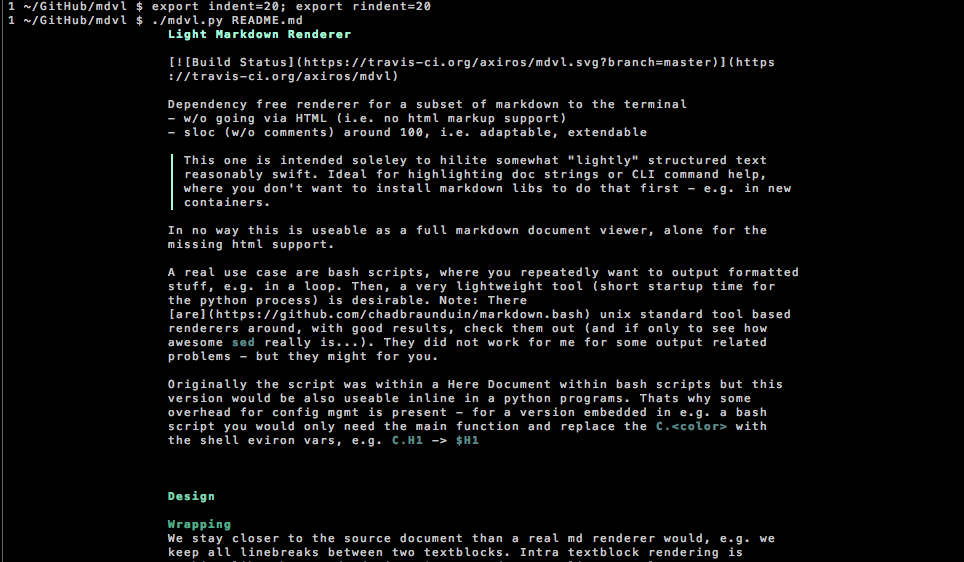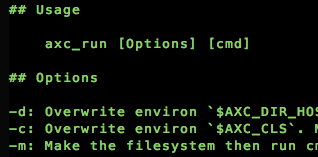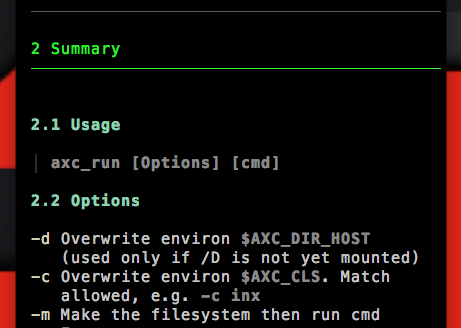Dependency free renderer for a subset of markdown to the terminal
- w/o going via HTML (i.e. no html markup support)
- sloc (w/o comments) around 100, i.e. adaptable, extendable
This one is intended soleley to hilite somewhat "lightly" structured text reasonably swift. Ideal for highlighting doc strings or CLI command help, where you don't want to install markdown libs to do that first - e.g. in new containers.
In no way this is useable as a full markdown document viewer, alone for the missing html support.
A real use case are bash scripts, where you repeatedly want to output formatted stuff, e.g. in a loop.
Then, a very lightweight tool (short startup time for the python process)
is desirable.
Note: There are
unix standard tool based renderers around, with good results, check them out
(and if only to see how awesome sed really is...).
They did not work for me for some output related problems - but they might for you.
Originally the script was within a Here Document within bash scripts but this
version would be also useable inline in a python programs. Thats why some
overhead for config mgmt is present - for a version embedded in e.g. a bash
script you would only need the main function and replace the C.<color> with
the shell eviron vars, e.g. C.H1 -> $H1
We assume the soure is already formatted with care and mdvl's main jobs are the coloring and the wrapping. Meaning that the source is formatted to be readable in environments w/o coloring and structure aware wrapping, specifically docstrings in source code editors.
Specifically this refers to the author using the markdown link reference feature
instead of spamming the source with long urls.
Seel also the handling of linespacing, below.
mdvl(source_markdown, **config)
cat README.md | ./mdvl.py
./mdv.py '''# Hello'''
./mdv.py README.md
We use #!/usr/bin/env python -Ss as shebang - which is not POSIX I had to learn, after seeing it fail on some Linuxes. Workaround is to call mdvl.py through an alias like python -Ss mdvl.py.
wget -q https://raw.githubusercontent.com/axiros/mdvl/master/mdvl.py
Yes, that url supports version pinning.
If you absolutely feel better with 10 files instead of one then do:
pip[3] install mdvl
Remember: This is not a very feature rich renderer. If you anyway already have pip on the system you want a real viewer, e.g. mdv.
Restricted set of md. This readme pretty much has them all in.
This is how the default output looks with default config.

Check attributes of classes Facts and Colors.
Those you can deliver as kw args or via environ. e.g.:
set -a; H1=171; H2=54; term_width=50; header_numbering=-1; set +a
./mdvl.py README.md
Blockquotes
- in different levels
- with lists
fenced code - or indented code
w/o syntax highlighting though
We stay closer to the source document than a real md renderer would, e.g. we keep all linebreaks between two textblocks. Intra textblock rendering is working like the standard, i.e. 2 spaces denote a linesep, else we wrap according to available columns.
Header Auto Numbering Set this parameter to a min. number of lines of markdown sources (-1 to switch feature off). When source document has more lines than this we'll autonumber the headers.
Light "Tables" Non standard - but somewhat handy for documenting e.g.
CLI Params of a command:
When first word of a line is starred, we set a starting indent for the
subsequent lines of that textblock to the length of that first word.
See rendering of this paragraph in mdvl.
That way you get an easy table-like presentation of lists with keywords,
which look good also in the source. See the screenshot of the rendered readme for a visual example.
If you don't need it, switch it off via no_smart_indent=True.
Options List Non standard as well. Formats lines like
-a: Option A
-b: Option B
nicely, i.e. with indented line wrapping and markup of the first word.
Trigger is that the first word of a line startswith '-', endswith ':'.
You can overwrite the triggers via opts_tbl_start and opts_tbl_end (which you
might want to use to switch that feature off).
we do not require two spaces for such options lists to line break. Add them if you render in standard renderers or preprocess them.
Horizontal Rules CommonMark allows to use 3 "-", "_" or star. We assign
different colors to them, see rendering of this README with mdvl.
Indents configure indent and/or width and/or rindent ("r" for right) to get the output indented
That feature comes handy if you want to nest to markdown sources, i.g. module
doc and function doc. 
Single Line Handling No leading line breaks, enables to use markdown within surrounding text.
Known and severe one is the problem of solicitated star characters. We currently can't detect them, the renderer assumes it is the beginning of an italic format and resets only at the next textblock :-(
The thing runs in Python2 and Python3 - for the frequent rendering use case you want Python 2:
# python -m timeit "import os; os.system('python -c \"i=1\"')"
100 loops, best of 3: 10 msec per loop
# python -m timeit "import os; os.system('python3 -c \"i=1\"')"
100 loops, best of 3: 18.1 msec per loop
# python -m timeit "import os; os.system('python -Ssc \"i=1\"')"
100 loops, best of 3: 4.2 msec per loop
# python -m timeit "import os; os.system('python3 -Ssc \"i=1\"')"
100 loops, best of 3: 10.6 msec per loop
Thats all - and demonstrates the horizontal rules ;-)

